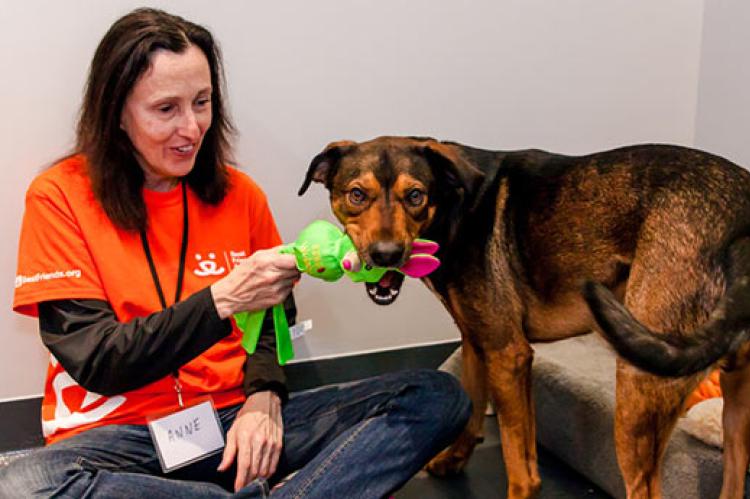Teaching Trades: Dog Training Plan

Why this is useful for your dog to know: Guarding resources (food, toys, locations, etc.) is a common and natural behavior in many dogs. They do it because they are afraid they’ll lose the resource. A lot of dog bites happen as a result of guarding. Practicing trades can help a dog feel better about having his stuff taken away. Implementing this training plan can reduce or eliminate a dog’s guarding, keeping him and everyone around him safe.
End behavior: The dog reacts happily to having food or high-value objects taken away from him.
Method 1
Step 1: Tether the dog to a secure fixture so he’ll stay in place. Start with a neutral object (one that the dog has no interest in, such as a book). Place the object directly in front of the dog (so it’s “his”).
Approach him from 10-15 feet away, and look for a “yippee” response — a relaxed, happy face, perky ears, tail wag. If he does not react with the “yippee” response (i.e., if he looks like he’ll guard the object), stop and look for a lower-value object. If you’re not sure about the dog’s response, contact a behavior professional.
When he reacts with the “yippee” response to your approach, pick up the object, give him a reward and some praise, and then put the object back in the same place, right in front of him, and walk away.
Practice this exercise from different directions and distances, and at varying time intervals, for 5 minutes a day, ideally at different times.
Step 2: Repeat Step 1 with an object that the dog likes but does not guard. For many dogs, this could be a low-value toy.
Step 3: Repeat Step 1 with an object that has moderate value to the dog. An example of this might be an empty Kong.
Step 4: Repeat Step 1 with an object that has slightly more value to the dog. An example is a Kong with a bully stick inside but not protruding at all.
Step 5: Repeat Step 1 with an object that has moderate to high value to the dog. An example of this might be a Kong with a bully stick protruding one quarter of an inch.
Step 6: Repeat Step 1 with a high-value object (e.g., the bully stick, with no Kong).
Proofing
Proofing means teaching the dog to generalize the behavior in different contexts.
Resource: Repeat Step 5, then Step 6, with different items that have high value to the dog.
Handler: Have other people start at the beginning of this training plan and work all the way through it. Try to get as many people as possible to do these trades with the dog so that he can generalize the trading concept to all people and objects. You will probably observe that the more people the dog has practiced with, the faster they’ll be able to work through the plan. Note: New people must always start at the beginning of the training plan.
Location: Practice the exercise yourself in different locations with the dog, then have other people practice in as many locations as possible, and with as many items as possible.
Maintain the behavior by practicing it on a regular basis. Remember to give the dog a high-value reward every time something that he values is taken away from him.
Notes
- If your dog is a severe resource guarder, or you feel at all unsure that you can implement this plan safely, please contact an experienced behavior professional.
- Until this training is complete, make sure that the dog never gets access to any high-value object that he should not have. If he does get something that you need to get away from him, distract him with treats first, far enough away from the object that you can take the object away without fearing for your safety. Wait until the dog is eating the treats before removing the object.
- Teach children never to go near any dog who is eating or has any object (even a toy).
Method 2
Some dogs go from zero to sixty when it comes to the value they place on objects; they go from having no interest to having extreme interest in an object. With these dogs, it can be difficult to find low- and medium-value items. If that’s the case with your dog, or you’re working with a dog who has a guarding history and you feel unsafe taking any object from him, use this method instead.
Step 1: Give the treats first, far enough away from the object that you can take the object away without fearing for your safety. Wait until the dog is eating the treats before removing the object. As soon as the dog is done with the treats, give the object back. Repeat this step only a few times, just long enough for the dog and you to get comfortable playing this game.
Step 2: Take the object and give the treats at the same time: keep the trades simultaneous. As soon as the dog is done with the treats, give the object back. Again, repeat this step only a few times, just long enough for the dog and you to get comfortable playing this game.
Note: These two steps should happen very quickly — within the same training session.
Step 3: Proceed to Step 1 of Method 1 above.
If you get stuck on any step, stop and take a break. When you try again, go back to the previous step in the plan. If necessary, create intermediate steps with intensity and duration that your dog is comfortable with. Don’t rush: Take it at the dog’s speed.